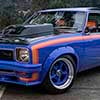Carbon Fibre lh/lx doors
Started by
_2runa_
, Jan 16 2009 10:54 PM
26 replies to this topic
#26

Posted 22 January 2009 - 08:02 PM
Well I retract the second half of my previous comment. I'm pleasantly suprised to hear that you could have CF intrusion bars 
#27
 _Baronvonrort_
_Baronvonrort_
Posted 23 January 2009 - 10:19 AM
It's not the tensile strength I'd be worried about, moreso the flexural.
Pat/Baron, what is the average flex strength of straight c/f?
I was under the impression that masts and wings, etc, needed spars of alloy or somesuch to aid the flex strength.
And how would it go under impact?
When it does go, c/f becomes razor shards too doesn't it?
Bit of extra infofor the old brain bucket. Carbon fibre is one of the few things I haven't ahd the chance to test.
Thanks fellas,
Grant..
If you want some technical info on mechanical properties of composites go to www.gurit.com and they have plenty of stuff to download.
Atl composites or fiberglass international are also suppliers in Australia.
Carbon masts for yacting are designed to be somewhat elastic near the tip to depower boat slightly when gust hits.Composite spars and tubes (aussie company) can make your mast have whatever flex characteristics you desire and the owner Clive worked for De Haviland before he went out on his own.The masts are also significantly loaded in compression below the hounds from rig tension.
Any serious racing sailboat has a carbon mast for weight saving and they are also smaller diameter for less windage and considerably stiffer holding rig tension far longer than an alloy tube and no contest on fatigue resistance.As the yachties say with carbon "once you go black you will never go back".
The Rutan Long ez was designed over 25 years ago and its wings are composite being epoxy/s glass and foam.The wing is constructed from a large piece of foam carved out and then glassed over pretty much the same way a surfboard is made apart from better materials.Burt sold plans for this plane to be built at home in your garage made from composite materials.Great fast economical 2 seater aeroplane.
Carbon can be razor sharp and splinters do hurt.The woven carbon/kevlar hybrid has gone out of vogue and most just use carbon as kevlar is poor in compression and you can still get splinters from the carbon in that fabric.Kevlar is a bitch to work with as hard to cut cleanly and you cant really sand it or the fibres go all fuzzy at surface.
If engineered properly carbon/nomex or alloy honeycomb/carbon can be excellent with impacts and comparing Martin Donelly crash on the lotus F1 about 25 years ago to Kubicas F1 BMW at Canada shows how far the understanding of these materials has advanced.
The Lotus exige/elise/elan/esprit/corvette all have fiberglass doors and the lotus does have an alloy side intrusion bar built into door.
Side impacts to me are what really need to be avoided and NACP will not give a 5 star rating to any car without side curtain airbags and i dont think they will even test cars with the pole for side impact without these airbags.
Some of the questions i would ask would be what resin did you use?What grade of cabon- low intermediate or high modulus?Was it vacum bagged?Was a composite engineer consulted or was a guesstimate used for material quantity?What was used to bond inner and outer skins?
Then you still have to deal with the fact carbon reacts with just about everything and all metal parts bolted to it will corrode from electrolysis so all bolts will probably have to be titanium or 316 stainless and everything else will have to be insulated from the carbon.
1 user(s) are reading this topic
0 members, 1 guests, 0 anonymous users




 View Garage
View Garage








